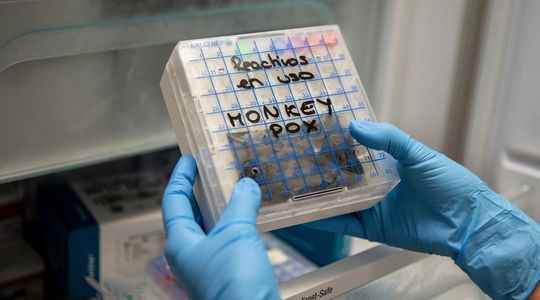Can we hope to end the monkeypox epidemic? For several weeks, this disease, close to smallpox and which causes in particular fevers and rashes, has been decreasing sharply in France and around the world. How will it evolve in the near or more distant future? The Committee for monitoring and anticipating health risks (Covars), which took over from the Scientific Council, looked into the question in a notice published earlier this week. “The current epidemic is decreasing in a major way”, but it “remains difficult” to assess the risks of rebound or resurgence of monkeypox due to a “large number of unknowns”, he underlines .
In France, just over 4,100 cases have been recorded since the start of the epidemic. The vast majority of them are found within the community of men who have homosexual relationships (MSM), and especially those who have relationships with multiple partners. Now, the dynamics of the epidemic are on the decline thanks to prevention within this community and vaccination. Several scenarios emerge in the short and medium term.
According to Covars, in the short term the most serious probability is that of a low noise circulation of the epidemic. Because if for the moment the trajectory could allow its elimination in France, the gradual relaxation of behavior, but also a drop in contact monitoring and insufficient vaccination would not make it possible to anticipate a real elimination of the virus. “This is one of the scenarios that we are considering with a high probability in the short term if the community at risk continues to be careful and we continue to strengthen vaccination”, warned the modeler at the Institut Pasteur Simon Cauchemez, during a press briefing on Monday 28 November. The resumption of the epidemic is not expected for the moment, “we cannot exclude it but it is not our preferred scenario in the short term”.
A very limited epidemic in the general population
In the medium and long term, Covars deems the elimination of mpox (renamed thus on November 28 by the WHO) on an international scale “unlikely” and therefore considers “a risk of epidemic resumption”, even “seasonal”, in France, even if the epidemic is under control by then. “France is not isolated and what happens there depends heavily on what happens internationally,” recalls Simon Cauchemez. According to him, the prospect of an elimination of the virus in MSM populations is unlikely even if it shows “encouraging” signs abroad, with “a very marked decrease for several months”. “The intensity of this reintroduction and the rebounds that could follow will depend on the vaccination coverage, the immunity in the population concerned and the capacity of the communities at risk to reintroduce behavioral changes in the event of re-emergence”, underlines the modeller.
Judging “very difficult to maintain risk reduction over time” by modifying behavior, the immunologist and president of Covars, Brigitte Autran insisted, during the press briefing, on a “complete vaccination, as quickly as possible, of the eligible population”. “If we succeed in vaccinating the individuals most at risk, we can have a huge impact on transmission,” insisted Simon Cauchemez. In France, the vaccine target has been estimated at approximately 300,000 people, and to date 170,000 doses of vaccine have been distributed (including 20,000 for the second dose).
Finally, since the dynamics of the epidemic are closely linked to the community of men who have sex with men and multiple partners, Covars emphasizes that the potential for transmission of the infection is low in the general population. As far as it is concerned, the impact of the epidemic remains limited in all the scenarios considered.
Relax biosecurity rules
The council insists on another axis: monitoring. For this, he recommends in particular to integrate monkeypox in the monitoring of sexually transmitted infections, even if this is not “the only way of entry of the virus”. By including monkeypox in this surveillance framework, it could be better monitored. “There is a very good network in France, the associations are very connected to this surveillance, the screening centers are effective, the sexual health care centers, the hospitals… so there is really an organization that must be used”, explained Brigitte Autran.
Finally, Covars also recommends a relaxation of biosecurity rules. This virus is currently categorized as Microorganisms and Toxins (MOT), a list of pathogens that can be used for terrorist purposes. And this framework very strictly limits its use. “Any laboratory that has this kind of pathogens must file a file with the National Medicines Agency, which details the storage conditions, the conditions of use, which personnel are authorized to handle or be in contact with the virus”, explains Bruno Lina, virologist and member of Covars. A constraint which forced the virology laboratories to adapt to send the diagnoses, and which complicated the care of patients. “We therefore recommend making this system more flexible, explains Bruno Lina, because in a context of emergence, you need a strategy to be able to support the laboratories in order to allow them to make the diagnoses”.
